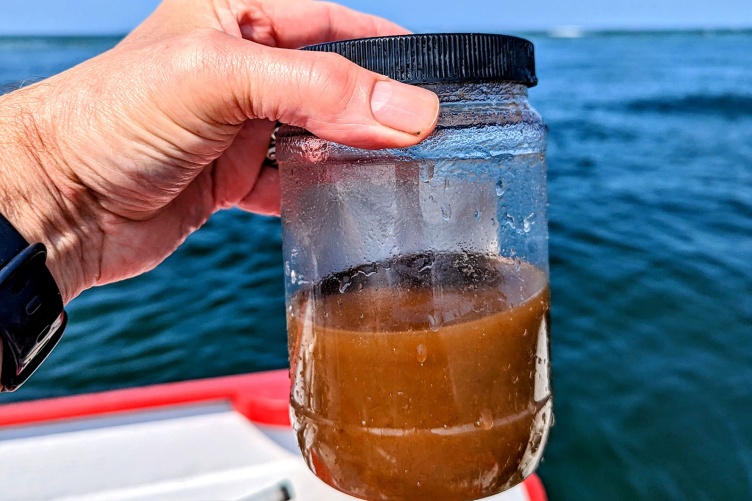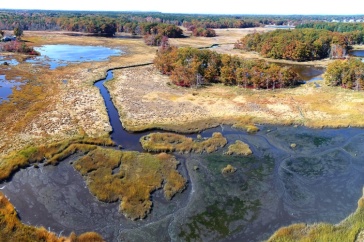
A nearshore Gulf of Maine water sample full of Tripos Muelleri collected in May 2023. Photo credit: Joe Vallino / Marine Biological Laboratory
A coffee-colored algal bloom covering a large expanse in the Gulf of Maine has captured the attention of scientists from across the region, who are calling this the highest concentration of brown microalgae they've ever seen in these waters at this time of year. Although not known to be dangerous, the sheer size and intensity of this bloom — which, at its peak, spanned more than 100 miles from Massachusetts to Maine this summer — is considered unusual, and so UNH scientists and other regional partners are taking steps to determine its cause and monitor any potential after-effects on marine life.
The bloom, or rapid growth of the algae, is predominately made up of dinoflagellate phytoplankton Tripos muelleri and has been found mostly in the water column under the surface. UNH scientists first took note of the bloom in April when they noticed significant changes in the ocean carbon dioxide (CO2) and pH levels they regularly monitor off the coast of New Hampshire.

Photo Credit: Liz Harvey / University of New Hampshire
“We were seeing the lowest CO2 levels and highest pH levels in surface water that we have observed in our twenty years of monitoring samples in the Gulf of Maine,” said Doug Vandemark, research professor at UNH’s Ocean Process Analysis Laboratory (OPAL). “We thought it might be related to the warming water in the Gulf of Maine and then we started to hear stories about marine filters being clogged with brown algae and other general nuisances from people working along the coast. We knew it wasn’t a coincidence.”
The UNH team took a proactive approach to this finding, and began to collect additional water samples to increase their monitoring which included phytoplankton counts, eDNA, nutrients, and carbon analyses. At the same time, they started to hear from other local scientists, marine operators and fisherman who were also documenting the unusual conditions throughout the Gulf of Maine. Together they assembled an informal consortium to share observations and data. The group now consists of over a dozen partners from Maine to Rhode Island and beyond. A partial list includes researchers at the National Oceanic and Atmospheric Administration (NOAA), Woods Hole Oceanographic Institution (WHOI), University of Maine, St. Joseph’s College of Maine, University of Massachusetts, Gulf of Maine Research Institute, Bigelow Laboratory for Ocean Sciences and Northeastern Regional Association of Coastal Ocean Observing Systems.
According to experts at WHOI’s Harmful Algal Bloom (HAB) Observing Network, the phytoplankton dominating this bloom, Tripos muelleri, does not produce a toxin and doesn’t present any known risks to humans or animals. However, high biomass blooms like this one have the potential to cause low oxygen conditions when they decay. This can negatively affect marine organisms, particularly ones inhabiting bottom waters and sediments. In general, seasonal blooms are a normal occurrence in high latitude marine ecosystems like the Gulf of Maine and are beneficial because the tiny plants provide food for animals and energy that fuels the ocean food web.
“It’s completely normal to see this species in the waters of the Gulf of Maine but never at this intensity,” said Liz Harvey, associate professor of biological sciences at UNH's College of Life Sciences and Agriculture. “At first it was intriguing but then it was larger than any of us had seen before and we thought, 'Wait, this is different' - and as researchers we want to understand the how and why and if it is a signal of a potentially changing Gulf of Maine.”
"As researchers, we want to understand the how and why and if it is a signal of a potentially changing Gulf of Maine."
Researchers say, in general, the high levels of phytoplankton seen in the spring usually decline in the summer months when nutrients that fuel the growth of phytoplankton decrease and animal populations like copepods, or small crustaceans, graze on them helping to reduce the bloom. However, this bloom of Tripos muelleri didn’t follow the traditional seasonal pattern. According to satellite imagery from NOAA, the phytoplankton bloom has steadily persisted since April and has been widespread, from Penobscot Bay to Martha's Vineyard. It is still not clear why this bloom formed and how it has been sustained across such a large area. Scientists are considering a number of triggers during the spring including decreased wind, the mild winter and the fact that Gulf of Maine is one of the fastest warming regions in the world. The heavy regional rainfall this summer may have contributed to the bloom’s uncommonly long duration.
“We’re still looking for answers and there is more work to do,” said Chris Hunt, research assistant professor at OPAL. “We’ve documented the massive growth of this species and the resulting changes in oxygen, CO2 and pH, but we are all still working to figure out what were the conditions that triggered this bloom in the first place, allowed it to last for so long and what happens to all the cells and organic matter once the bloom is over?”
Potential After Effects of the Bloom
The consortium of researchers has coordinated efforts to collect more water samples in the region over the coming months. Recent data shows that the bloom may be starting to fade along the shore but they are working to determine if this is also happening further offshore. The team is also attempting to monitor the Gulf of Maine closely for any signs of hypoxia — low oxygen conditions that can affect marine life. As the phytoplankton begins to fade, or die off, they sink to the bottom of the ocean and are consumed by bacteria, which can deplete oxygen and could have an effect on fish, shellfish and lobster. The last known time something like that happened with this same species along the East coast was almost fifty years ago in 1976 over the New York Bight when a large bloom created hypoxic conditions after it died off. This impacted commercial shellfish and fish stocks.

near Georges Bank by NOAA’s R/V Henry B. Bigelow in early May 2023. Photo credit: Katy McGinnis / NOAA.
“It is too soon to tell if this Tripos muelleri bloom might lead to a hypoxia event similar to the one in 1976,” said Vandemark. “What is important now is that we continue to monitor into the fall, and then try to understand the bloom, any possible impacts and if we could expect more like it in the future.”
The team of scientists from UNH and several other regional insitutions that regularly collect water samples are leading a multi-pronged data collection effort that includes analyzing key indicators like water temperature, salinity, chlorophyll, nutrients, CO2 and pH levels; continued tracking of the bloom by using satellite imagery of chlorophyll concentrations from NOAA; oxygen sensors on lobster traps deployed by commercial fishermen participating in the eMOLT program; and the collection of phytoplankton, zooplankton, nutrients, oxygen and carbon samples across the Gulf of Maine by NOAA’s NEFSC Ecosystem Monitoring surveys. The team of scientists will continue to monitor conditions over the next few months and is planning to meet as a working group in the fall to analyze all the data.
Support for UNH Gulf of Maine monitoring is provided by the Gulf of Maine Marine Biodiversity Observation Network led by NERACOOS and the University of Maine which is funded by NOAA and the Bureau of Ocean Energy Management. Additional support is provided by NOAA’s Ocean Acidification program and the Office of Naval research.
The UNH Institute for the Study of Earth, Oceans, and Space (EOS) is UNH's largest research enterprise, comprising six centers with a focus on interdisciplinary, high-impact research on Earth and climate systems, space science, the marine environment, seafloor mapping and environmental acoustics. With approximately 100 principal investigators managing more than 400 individual grant awards, and with annual expenditures exceeding $95 million, EOS fosters an intellectual and scientific environment that advances visionary scholarship and leadership in world-class and graduate education.
-
Written By:
Robbin Ray ’82 | UNH Marketing | robbin.ray@unh.edu | 603-862-4864

















































